Influence of Loading History and Soil Type on the Normal Contact Behavior of Natural Sand Grain-Elastomer Composite Interfaces
Abstract
:1. Introduction
2. Materials and Methods
2.1. Materials Used and Their Compositional and Morphological Characterization
2.2. Experimental Setup for Normal Contact Tests
2.3. Testing Program
3. Results and Discussion
3.1. Cyclic Normal Load Tests without Preloading (CP Tests)
3.1.1. Rigid Interfaces
3.1.2. Rigid–Soft Interfaces
3.2. Cyclic Normal Load Tests with Preloading (PP Tests)
3.2.1. Rigid Interfaces
3.2.2. Rigid–Soft Interfaces
3.3. Energy Dissipation in Cyclic Tests
3.4. Theoretical Analysis Using Hertz Fitting
3.4.1. Background of Model and Sensitivity Analysis
3.4.2. Data Analysis
4. Summary, Conclusions, and Recommendations for Future Research
- (1)
- In CP tests of rigid interfaces, LBS grains displayed predominantly elastic response (accounting for only 14% of plastic displacements in cycle-1); however, for CDG, a significant portion of the total displacement was plastic in cycle-1 (80%), and in consecutive cycles, the portion of plastic displacements, despite some fluctuations, stabilized (around 20%). These differences were attributed to the rougher texture and the presence of coating of microparticles on the surfaces of the CDG grains. For BLS, even though their behavior was similar compared to that of LBS in cycle-2 to cycle-10, they displayed greater plastic displacements owing to their rougher texture. A major difference between BLS and CDG was that consecutive cycles resulted in extremely small plastic fractions of displacement for BLS, whereas the cycle number had a continuous influence, with resultant plastic displacement for CDG. These data suggested that the heavy coating of microparticles might be a more prevalent factor controlling the normal contact behavior of the grains.
- (2)
- The data suggested that while for the CP tests, the behavior of the rigid grain contacts was majorly elastic–plastic (i.e., the plasticity of asperities contributes to the measured irreversible strains as well as the irrecoverable compression of the coating), in PP tests, some brittle type of response also contributes to the normal contact behavior of rigid interfaces, especially for CDG.
- (3)
- The composite (rigid–soft) interfaces displayed similar behavior in cycle-2 to cycle-10, which was found almost independent on sand grain type, even though differences were observed in cycle-1. The composite interfaces also displayed some level of plastic deformations, which was subsequently discussed to be an additional mechanism of plastic behavior as observed in element-size experimental tests of sand–rubber mixtures as reported in the literature.
- (4)
- Theoretical analysis of the developed contact stresses in CP tests (maximum normal load of 10 N) revealed that rigid interfaces (using data on LBS) had much greater developed contact stresses of the order of 150 MPa, while the contact stresses were reduced to 10% of these estimated values for rigid–soft interfaces. This theoretical analysis provided a mechanism of mitigation of stress concentration in binary mixtures preventing sand grain breakage.
- (5)
- Quantification of the normal contact stiffness revealed very high values for LBS contacts compared with CDG and BLS, even though all the rigid contacts had at least one order of magnitude higher stiffness compared with that of rigid–soft interfaces. These data may provide some useful guide as input values in DEM simulations of binary (composite) granular materials. The viscoelastic nature of rubber grains also contributed to significantly non-linear behavior in the unloading curves of the composite interfaces, which, as also discussed for other polymeric-based materials in the literature, was attributed to the relaxation of the rubber grains.
- (6)
- The data from the present study comprise a solid basis for future research on composite interfaces. One of these directions can be the investigation of sand–rubber interactions accounting for the potential influence of loading rate (or loading frequency) as well as the influence of temperature on the contact behavior of rigid–soft interfaces. More systematic studies into the behavior of rigid–soft interfaces would also be promising by examining different types of polymeric materials (other than granulated rubber).
Author Contributions
Funding
Institutional Review Board Statement
Informed Consent Statement
Data Availability Statement
Conflicts of Interest
References
- Ahmed, I.; Lovell, C. Rubber soils as lightweight geomaterials. Transp. Res. Rec. 1993, 1422, 61–70. [Google Scholar]
- Edil, T.B.; Bosscher, P.J. Engineering properties of tire chips and soil mixtures. Geotech. Test. J. 1994, 17, 453–464. [Google Scholar]
- Narejo, D.B.; Shettima, M. Use of recycled automobile tires to design landfill components. Geosynth. Int. 1995, 2, 619–625. [Google Scholar] [CrossRef]
- Foose, G.J.; Benson, C.H.; Bosscher, P.J. Sand reinforced with shredded waste tires. J. Geotech. Eng. 1996, 122, 760–767. [Google Scholar] [CrossRef]
- Bernal, A.; Salgado, R.; Swan, R.H., Jr.; Lovell, C.W. Interaction between tire shreds, rubber-sand and geosynthetics. Geosynth. Int. 1997, 4, 623–643. [Google Scholar] [CrossRef]
- Reddy, K.R.; Saichek, R.E. Characterization and performance assessment of shredded scrap tires as leachate drainage material in landfills. In Proceedings of the 14th International Conference on Solid Waste Technology and Management, Philadelphia, PA, USA, 1–4 November 1998. [Google Scholar]
- Feng, Z.Y.; Sutter, K.G. Dynamic properties of granulated rubber/sand mixtures. Geotech. Test. J. 2000, 23, 338–344. [Google Scholar]
- Edil, T.B. A review of Mechanical and Chemical Properties of Shredded Tires and Soil Mixtures. In Recycled Materials in Geotechnics, Geotechnical Special Publication; Aydilek, A.H., Wartman, J., Eds.; ASCE: Reston, VA, USA, 2004; Volume 127, pp. 1–21. [Google Scholar]
- Edeskar, T. Use of Tyre Shreds in Civil Engineering Applications—Technical and Environmental Properties. Ph.D. Thesis, Division of Mining and Geotechnical Engineering, Department of Civil and Environmental Engineering, Lulea University of Technology, Lulea, Sweden, 2006. [Google Scholar]
- ASTM. Standard Practice for Use of Scrap Tires in Civil Engineering Applications; ASTM International: West Conshohocken, PA, USA, 2008. [Google Scholar]
- Bosscher, P.J.; Edil, T.B.; Eldin, N. Construction and Performance of Shredded Tire Test Embankment; Report; Transportation Research Board: Washington, DC, USA, 1993; pp. 44–52. [Google Scholar]
- Humphrey, D.N.; Sandford, T.C. Tire Chips as Lightweight Subgrade Fill and Retaining Wall Backfill. In Symposium Proceedings: Recovery and Effective Reuse of Discarded Materials and By-Products for Construction of Highway Facilities; US Department of Transportation, Federal Highway Administration: Washington, DC, USA, 1993; pp. 5–87. [Google Scholar]
- Hoppe, E.J. Field Study of a Shredded Tire Embankment; Report, VTRC 94-IR1; Virginia Transportation Research Council: Charlottesville, VA, USA, 1994. [Google Scholar]
- Humphrey, D.N. Effectiveness of Design Guidelines for Use of Tire Derived Aggregate as Lightweight Embankment Fill; Recycled Materials in Geotechnics, Geotechnical Special Publication; ASCE: Arlington, VA, USA, 2004; pp. 61–74. [Google Scholar]
- Edincliler, A. Using waste tire-soil mixtures for embankment construction. In Proceedings of the International Workshop on Scrap Tire Derived Geomaterials-Opportunities and Challenges, Yokosuka, Japan, 23–24 March 2007; pp. 319–328. [Google Scholar]
- Edincliler, A.; Cagatay, A. Weak subgrade improvement with rubber fibre inclusions. Geosynth. Int. 2013, 20, 39–46. [Google Scholar] [CrossRef]
- Humphrey, D.N.; Cosgrove, T.; Whetten, N.L.; Herbert, R. Tire Chips Reduce Lateral Earth Pressure against the Walls of a Rigid Frame Bridge. In Seminar on Rehabilitation and Upgrades in Civil and Environmental Engineering, Orono, Maine; ASCE: Reston, VA, USA, 1997. [Google Scholar]
- Lee, J.H.; Salgado, R.; Bernal, A.; Lovell, C. Shredded tires and rubber-sand as lightweight backfill. J. Geotech. Geoenviron. Eng. 1999, 125, 132–141. [Google Scholar] [CrossRef]
- Abichou, T.; Tawfiq, K.; Edil, T.B.; Benson, C.H. Behavior of a Soil-tire shreds backfill for dodular block-wall, recycled materials in geotechnics. Geotech. Spec. Publ. 2004, 127, 162–172. [Google Scholar]
- Kaneda, K.; Hazarika, H.; Yamazaki, H. The numerical simulation of earth pressure reduction using tire chips in backfill. In Proceedings of the International Workshop on Scrap Tire Derived Geomaterials—Opportunities and Challenges, Yokosuka, Japan, 23–24 March 2007; pp. 245–251. [Google Scholar]
- Tsang, H.H. Seismic isolation by rubber–soil mixtures for developing countries. Earthq. Eng. Struct. Dyn. 2008, 37, 83–303. [Google Scholar] [CrossRef]
- Senetakis, K.; Anastasiadis, A.; Trevlopoulos, K.; Pitilakis, K. Dynamic Response of SDOF systems on soil replaced with sand/rubber mixture. In Proceedings of the ECOMAS Thematic Conference on Computation Methods in Structural Dynamics and Earthquake Engineering, Rhodes, Greece, 22–24 June 2009. [Google Scholar]
- Mavronicola, E.; Komodromos, P.; Charmpis, D.C. Numerical investigation of potential usage of rubber soil mixtures as a distributed seismic isolation approach. In Proceedings of the Tenth International Conference on Computational Structures Technology, Valencia, Spain, 14–17 September 2010; Civil-Comp Press: Stirlingshire, UK, 2010; p. 168. [Google Scholar]
- Pitilakis, K.; Trevlopoulos, K.; Anastasiadis, A.; Senetakis, K. Seismic response of structures on improved soil. In Proceedings of the 8th International Conference on Structural Dynamics (EURODYN2011), European Association for Structural Dynamics, Leuven, Belgium, 4–6 July 2011. [Google Scholar]
- Uchimura, T.; Chi, N.; Nirmalan, S.; Sato, T.; Meidani, M.; Towhata, I. Shaking table tests on effect of tire chips and sand mixture in increasing liquefaction resistance and mitigating uplift of pipe. In Proceedings of the International Workshop on Scrap Tire Derived Geomaterials—Opportunities and Challenges, Yokosuka, Japan, 23–24 March 2007; pp. 179–186. [Google Scholar]
- Hazarika, H.; Kohama, E.; Sugano, T. Underwater shake table tests on waterfront structures protected with tire chips cushion. J. Geotech. Geoenviron. Eng. 2008, 134, 1706–1719. [Google Scholar] [CrossRef]
- Hazarika, H.; Pasha, S.M.K.; Ishibashi, I.; Yoshimoto, N.; Kinoshita, T.; Endo, S.; Karmokar, A.K.; Hitosugi, T. Tire-chip reinforced foundation as liquefaction countermeasure for residential buildings. Soils Found. 2020, 60, 315–326. [Google Scholar] [CrossRef]
- Li, B.; Huang, M.; Zeng, X. Dynamic behavior and liquefaction analysis of recycled-rubber sand mixtures. J. Mater. Civ. Eng. 2016, 28, 04016122. [Google Scholar] [CrossRef]
- Esmaeili, M.; Zakeri, J.A.; Ebrahimi, H.; Khadem Sameni, M. Experimental study on dynamic properties of railway ballast mixed with tire derived aggregate by modal shaker test. Adv. Mech. Eng. 2016, 8, 1–13. [Google Scholar] [CrossRef] [Green Version]
- Ma, Y.; Wang, S.; Zhou, H.; Hu, W.; Polaczyk, P.; Zhang, M.; Huang, B. Compatibility and rheological characterization of asphalt modified with recycled rubber-plastic blends. Constr. Build. Mater. 2021, 270, 121416. [Google Scholar] [CrossRef]
- Akbarzadeh Bengar, H.; Ali Shahmansouri, A.; Akkas Zangebari Sabet, N.; Kabirifar, K.; Tam, V.W.Y. Impact of elevated temperatures on the structural performance of recycled rubber concrete: Experimental and mathematical modeling. Constr. Build. Mater. 2020, 255, 119374. [Google Scholar] [CrossRef]
- Li, Y.; Yang, X.; Lou, P.; Wang, R.; Li, Y.; Si, Z. Sulfate attack resistance of recycled aggregate concrete with NaOH-solution-treated crumb rubber. Constr. Build. Mater. 2021, 287, 123044. [Google Scholar] [CrossRef]
- Irtiseva, K.; Lapkovskis, V.; Mironovs, V.; Ozolins, J.; Thakur, V.K.; Goel, G.; Baronins, J.; Shishkin, A. Towards Next-Generation Sustainable Composites Made of Recycled Rubber, Cenospheres, and Biobinder. Polymers 2021, 13, 574. [Google Scholar] [CrossRef]
- Marín-Genescà, M.; García-Amorós, J.; Mujal-Rosas, R.; Massagués, L.; Colom, X. Study and Characterization of the Dielectric Behavior of Low Linear Density Polyethylene Composites Mixed with Ground Tire Rubber Particles. Polymers 2020, 12, 1075. [Google Scholar] [CrossRef]
- Burak Irez, A.; Bayraktar, E.; Miskioglu, I. Fracture Toughness Analysis of Epoxy-Recycled Rubber-Based Composite Reinforced with Graphene Nanoplatelets for Structural Applications in Automotive and Aeronautics. Polymers 2020, 12, 448. [Google Scholar] [CrossRef] [PubMed] [Green Version]
- Masad, E.; Taha, R.; Ho, C.; Papagiannakis, T. Engineering properties of tire/soil mixtures as a lightweight fill material. Geotech. Test. J. 1996, 19, 297–304. [Google Scholar]
- Zornberg, J.G.; Cabral, A.R.; Viratjandr, C. Behaviour of tire shred sand mixtures. Can. Geotech. J. 2004, 41, 227–241. [Google Scholar] [CrossRef]
- Hyodo, M.; Yamada, S.; Orense, R.; Okamoto, M.; Hazarika, H. Undrained cyclic shear properties of tire chip-sand mixtures. In Proceedings of the International Workshop on Scrap Tire Derived Geomaterials—Opportunities and Challenges, Yokosuka, Japan, 23–24 March 2007; pp. 187–196. [Google Scholar]
- Edincliler, A.; Ayhan, V. Influence of tyre fiber inclusions on shear strength of sand. Geosynth. Int. 2007, 17, 183–192. [Google Scholar] [CrossRef]
- Anastasiadis, A.; Senetakis, K.; Pitilakis, K. Small-strain shear modulus and damping ratio of sand-rubber and gravel-rubber mixtures. Geotech. Geol. Eng. 2012, 30, 363–382. [Google Scholar] [CrossRef]
- Senetakis, K.; Anastasiadis, A.; Pitilakis, K. Dynamic properties of dry sand/rubber (SRM) and gravel/rubber (GRM) mixtures in a wide range of shearing strain amplitudes. Soil Dyn. Earthq. Eng. 2012, 33, 38–53. [Google Scholar] [CrossRef]
- Senetakis, K.; Anastasiadis, A. Effects of state of test sample, specimen geometry and sample preparation on dynamic properties of rubber–sand mixtures. Geosynth. Int. 2015, 22, 301–310. [Google Scholar] [CrossRef] [Green Version]
- Fu, R.; Coop, M.R.; Li, X. The mechanics of a compressive sand mixed with tyre rubber. Geotech. Lett. 2014, 4, 238–243. [Google Scholar] [CrossRef]
- Fu, R.; Coop, M.R.; Senetakis, K.; Li, X. An Investigation of the Particle Breakage Behaviour of Rubber Reinforced Sand. In Geomechanics from Micro to Macro, Proceedings of the TC 105 ISSMGE International Symposium on Geomechanics from Micro to Macro, Cambridge, UK, 1–3 September 2015; CRC Press: Boca Raton, FL, USA, 2015; pp. 1347–1350. [Google Scholar]
- Mashiri, M.S.; Vinod, J.S.; Sheikh, M.N.; Tsang, H.H. Shear strength and dilatancy behaviour of sand-tyre chip mixtures. Soils Found. 2015, 55, 517–528. [Google Scholar] [CrossRef] [Green Version]
- Li, W.; Kwok, C.Y.; Sandeep, C.S.; Senetakis, K. Sand type effect on the behaviour of sand-granulated rubber mixtures: Integrated study from micro-to macro-scales. Powder Technol. 2019, 342, 907–916. [Google Scholar] [CrossRef]
- Li, W.; Kwok, C.Y.; Senetakis, K. Effects of Inclusion of Granulated Rubber Tyres on the Mechanical Behaviour of a Compressive Sand. Can. Geotech. J. 2019, 57, 763–769. [Google Scholar] [CrossRef]
- Lee, C.; Shin, H.; Lee, J.S. Behaviour of sand–rubber particle mixture: Experimental observations and numerical simulations. Int. J. Numer. Methods Eng. 2014, 38, 1651–1663. [Google Scholar] [CrossRef]
- He, H.; Senetakis, K.; Coop, M.R. An investigation of the effect of shearing velocity on the inter-particle behavior of granular and composite materials with a new micromechanical dynamic testing apparatus. Tribol. Int. 2019, 134, 252–263. [Google Scholar] [CrossRef] [Green Version]
- Cheng, Z.; Wang, J.; Li, W. The micro-mechanical behaviour of sand–rubber mixtures under shear: An experimental study based on X-ray micro-tomography. Soils Found. 2020, 60, 1251–1268. [Google Scholar] [CrossRef]
- Tizpa, P.; Kazempour, S.; Jamshidi Chenari, R.; Farrokhi, F.; Ahmadi, H. Numerical and experimental investigations of the influence of grain size on the compressibility of sand–EPS mixtures. Int. J. Geosynth. Ground Eng. 2019, 5, 30. [Google Scholar] [CrossRef]
- Jamshidi Chenari, R.; Karimpour Fard, M.; Pourghaffar Maghfarati, S.; Pishgar, F.; Lemos Machado, S. An investigation on the geotechnical properties of sand–EPS mixture using large oedometer apparatus. Constr. Build. Mater. 2016, 113, 773–782. [Google Scholar] [CrossRef]
- Tizpa, P.; Jamshidi Chenari, R.; Farrokhi, F. A note on the compressibility and earth pressure properties of EPS beads-rigid particulates composite. Geotech. Geol. Eng. 2019, 37, 5231–5243. [Google Scholar] [CrossRef]
- Lee, J.S.; Dodds, J.; Santamarina, J.C. Behavior of rigid-soft particle mixtures. J. Mater. Civ. Eng. 2007, 19, 179–184. [Google Scholar] [CrossRef] [Green Version]
- Kim, H.K.; Santamarina, J.C. Sand–rubber mixtures (large rubber chips). Can. Geotech. J. 2008, 45, 1457–1466. [Google Scholar] [CrossRef] [Green Version]
- Lopera Perez, J.C.; Kwok, C.Y.; Senetakis, K. Effect of rubber size on the behaviour of sand-rubber mixtures: A numerical investigation. Comput. Geotech. 2016, 80, 199–214. [Google Scholar] [CrossRef]
- Lopera Perez, J.C.; Kwok, C.Y.; Senetakis, K. Micromechanical analyses of the effect of rubber size and content on sand-rubber mixtures at the critical state. Geotext. Geomembr. 2017, 45, 1–17. [Google Scholar] [CrossRef]
- Fu, R.; Coop, M.R.; Li, X. Influence of particle type on the mechanics of sand–rubber mixtures. J. Geotech. Geoenviron. Eng. 2017, 143, 04017059. [Google Scholar] [CrossRef] [Green Version]
- Tian, Y.; Senetakis, K. Influence of creep on the small-strain stiffness of sand-rubber mixtures. Geotechnique 2021. [Google Scholar] [CrossRef]
- Sazzad, M.M.; Suzuki, K. Effect of interparticle friction on the cyclic behavior of granular materials using 2D DEM. J. Geotech. Geoenviron. Eng. 2011, 137, 545–549. [Google Scholar] [CrossRef]
- Huang, X.; Hanley, K.J.; O’Sullivan, C.; Kwok, C.Y. Exploring the influence of interparticle friction on critical state behaviour using DEM. Int. J. Numer. Anal. Methods Geomech. 2014, 38, 1276–1297. [Google Scholar] [CrossRef]
- Mollon, G.; Quacquarelli, A.; Andò, E.; Viggiani, G. Can friction replace roughness in the numerical simulation of granular materials. Granul. Matter 2020, 22, 1–16. [Google Scholar] [CrossRef]
- Valdes, J.R.; Evans, T.M. Sand–rubber mixtures: Experiments and numerical simulations. Can. Geotech. J. 2008, 45, 588–595. [Google Scholar] [CrossRef]
- Evans, T.M.; Valdes, J.R. The microstructure of particulate mixtures in one-dimensional compression: Numerical studies. Granul. Matter 2011, 13, 657–669. [Google Scholar] [CrossRef]
- Lopera Perez, J.C.; Kwok, C.Y.; Senetakis, K. Investigation of the micro-mechanics of sand–rubber mixtures at very small strains. Geosynth. Int. 2017, 24, 30–44. [Google Scholar] [CrossRef] [Green Version]
- Asadi, M.; Thoeni, K.; Mahboubi, A. An experimental and numerical study on the compressive behavior of sand-rubber particle mixtures. Comput. Geotech. 2018, 104, 185–195. [Google Scholar] [CrossRef]
- Zhang, J.; Zhang, J.; Chen, X.; Wang, X. Microscopic investigation of the packing features of soft-rigid particle mixtures using the discrete element method. Adv. Powder Technol. 2020, 31, 2951–2963. [Google Scholar] [CrossRef]
- Tizpa, P.; Jamshidi Chenari, R.; Farrokhi, F. Constraint deformation behavior of sand-EPS beads mixture using discrete element modeling (DEM). Adv. Civ. Eng. Mater. 2020, 9. [Google Scholar] [CrossRef]
- Sandeep, C.S.; Senetakis, K. Exploring the micromechanical sliding behavior of typical quartz grains and completely decomposed volcanic granules subjected to repeating shearing. Energies 2017, 10, 370. [Google Scholar] [CrossRef] [Green Version]
- Sandeep, C.S.; Senetakis, K. Effect of Young’s modulus and surface roughness on the inter-particle friction of granular materials. Materials 2018, 11, 217. [Google Scholar] [CrossRef] [PubMed] [Green Version]
- Sandeep, C.S.; Senetakis, K. Grain-scale mechanics of quartz sand under normal and tangential loading. Tribol. Int. 2018, 117, 261–271. [Google Scholar] [CrossRef]
- Kasyap, S.S.; Li, S.; Senetakis, K. Investigation of the mechanical properties and the influence of micro-structural characteristics of aggregates using micro-indentation and Weibull analysis. Constr. Build. Mater. 2021, 271, 121509. [Google Scholar] [CrossRef]
- Sandeep, C.S.; Senetakis, K. The tribological behavior of two potential-landslide saprolitic rocks. Pure Appl. Geophys. 2018, 175, 4483–4499. [Google Scholar] [CrossRef]
- Rocchi, I. An Experimental Investigation of the Influence of Weathering on Saprolitic Soils from Hong Kong; Architechture and Civil Engineering Department, City University of Hong Kong: Hong Kong, China, 2014. [Google Scholar]
- Sandeep, C.S. Micromechanics of Hong Kong Debris Flow Materials; Architecture and Civil Engineering Department, City University of Hong Kong: Hong Kong, China, 2019. [Google Scholar]
- Sandeep, C.S.; Todisco, M.C.; Nardelli, V.; Senetakis, K.; Coop, M.R.; Lourenco, S. A micromechanical experimental study of highly/completely decomposed tuff granules. Acta Geotech. 2018, 13, 1355–1367. [Google Scholar] [CrossRef] [Green Version]
- Kasyap, S.S.; Senetakis, K.; Zhao, J. Cyclic normal load–displacement behaviour of clay-coated sand grain contacts. Geotechnique 2019, 71, 216–225. [Google Scholar] [CrossRef]
- Kasyap, S.S.; Li, S.; Senetakis, K. Influence of natural coating type on the frictional and abrasion behaviour of siliciclastic-coated sedimentary sand grains. Eng. Geol. 2021, 281, 105983. [Google Scholar] [CrossRef]
- He, H.; Sandeep, C.S.; Senetakis, K. The interface behavior of recycled concrete aggregate: A micromechanical grain-scale experimental study. Constr. Build. Mater. 2019, 210, 627–638. [Google Scholar] [CrossRef]
- Sandeep, C.S.; Senetakis, K. Influence of morphology on the micro-mechanical behavior of soil grain contacts. Geomech. Geophys. Geoenergy Georesources 2019, 5, 103–119. [Google Scholar] [CrossRef]
- Sandeep, C.S.; He, H.; Senetakis, K. An experimental micromechanical study of sand grain contacts behavior from different geological environments. Eng. Geol. 2018, 246, 176–186. [Google Scholar] [CrossRef]
- Sandeep, C.S.; Li, S.; Senetakis, K. Scale and surface morphology effects on the micromechanical contact behavior of granular materials. Tribol. Int. 2021. [Google Scholar] [CrossRef]
- Nadimi, S.; Ghanbarzadeh, A.; Neville, A.; Ghadiri, M. Effect of particle roughness on the bulk deformation using coupled boundary element and discrete element methods. Comput. Part. Mech. 2020, 7, 603–613. [Google Scholar] [CrossRef] [Green Version]
- Nadimi, S.; Otsubo, M.; Fonseca, J.; O’Sullivan, C. Numerical modelling of rough particle contacts subject to normal and tangential loading. Granul. Matter 2019, 108, 1–14. [Google Scholar] [CrossRef] [Green Version]
- Marzulli, V.; Sandeep, C.S.; Senetakis, K.; Cafaro, F.; Pöschel, T. Scale and water effects on the friction angles of two granular soils with different roughness. Powder Technol. 2021, 377, 813–826. [Google Scholar] [CrossRef]
- Johnson, K.L. Contact Mechanics; Cambridge University Press: Cambridge, UK, 1985. [Google Scholar]
- Senetakis, K.; Coop, M.R. The development of a new micro-mechanical inter-particle loading apparatus. Geotech. Test. J. 2014, 37, 1028–1039. [Google Scholar] [CrossRef]
- Nardelli, V. An Experimental Investigation of the Micromechanical Contact Behavior of Soils; Architechture and Civil Engineering Department, City University of Hong Kong: Hong Kong, China, 2017. [Google Scholar]
- Kasyap, S.S.; Senetakis, K. A micromechanical experimental study of kaolinite-coated sand grains. Tribol. Int. 2018, 126, 206–217. [Google Scholar] [CrossRef]
- Mate, C.M. Tribology on the Small Scale: A Bottom up Approach to Friction, Lubrication, and Wear; Oxford University Press: Oxford, UK, 2008. [Google Scholar]
- Liu, L.; Cai, G.; Liu, S. Compression properties and micro-mechanisms of rubber-sand particle mixtures considering grain breakage. Constr. Build. Mater. 2018, 187, 1061–1072. [Google Scholar] [CrossRef]
- Neaz Sheikh, M.; Mashiri, M.S.; Vinod, J.S.; Tsang, H.H. Shear and compressibility behavior of sand–tire crumb mixtures. J. Mater. Civ. Eng. 2013, 25, 1366–1374. [Google Scholar] [CrossRef]
- Sandeep, C.S.; Marzulli, V.; Cafaro, F.; Senetakis, K.; Pöschel, T. Micromechanical Behavior of DNA-1A Lunar Regolith Simulant in Comparison to Ottawa Sand. J. Geophys. Res. Solid Earth 2019, 124, 8077–8100. [Google Scholar] [CrossRef]
- Oliver, W.C.; Pharr, G.M. A new improved technique for determining hardness and elastic modulus using load and sensing indentation experiments. J. Mater. Res. 1992, 7, 1564–1582. [Google Scholar] [CrossRef]
- Oliver, D.J.; Bradby, J.E.; Williams, J.S.; Swain, M.V.; Munroe, P. Giant pop-ins and amorphization in germanium during indentation. J. Appl. Phys. 2007, 101, 043524. [Google Scholar] [CrossRef] [Green Version]
- Taleie, S.M.; Oskouei, A.V.; Moghaddam, H. Experimental investigation of FRP relaxation and its effect on pre-stressing techniques. In Proceedings of the 8th International Symposium on FRP Reinforcement for Concrete Structures, Patras, Greece, 16–18 July 2007. [Google Scholar]
- Goertzen, W.K.; Kessler, M. Creep behavior of carbon fiber/epoxy matrix composites. Mater. Sci. Eng. A 2006, 421, 217–225. [Google Scholar] [CrossRef]
- Zou, P.X.W. Long-term properties and transfer length of fiber-reinforced polymers. J. Compos. Constr. 2003, 7, 10–19. [Google Scholar] [CrossRef]
- Qi, Y.; Indraratna, B.; Coop, M.R. Predicted behavior of saturated granular waste blended with rubber crumbs. Int. J. Geomech. 2019, 19, 04019079. [Google Scholar] [CrossRef] [Green Version]
- Hertz, H. Über die Berührung fester elastischer Körper. J. Reine Angew. Math. 1882, 92, 156–171. [Google Scholar]
- O’Sullivan, C. Particulate Discrete Element Modelling: A Geomechanics Perspective. In Applied Geotechnics; Spon Press: London, UK, 2011; Volume 4. [Google Scholar]
- Kasyap, S.S.; Senetakis, K. Interface load-displacement behaviour of sand grains coated with clayey powder: Experimental and analytical studies. Soils Found. 2019, 59, 1695–1710. [Google Scholar] [CrossRef]


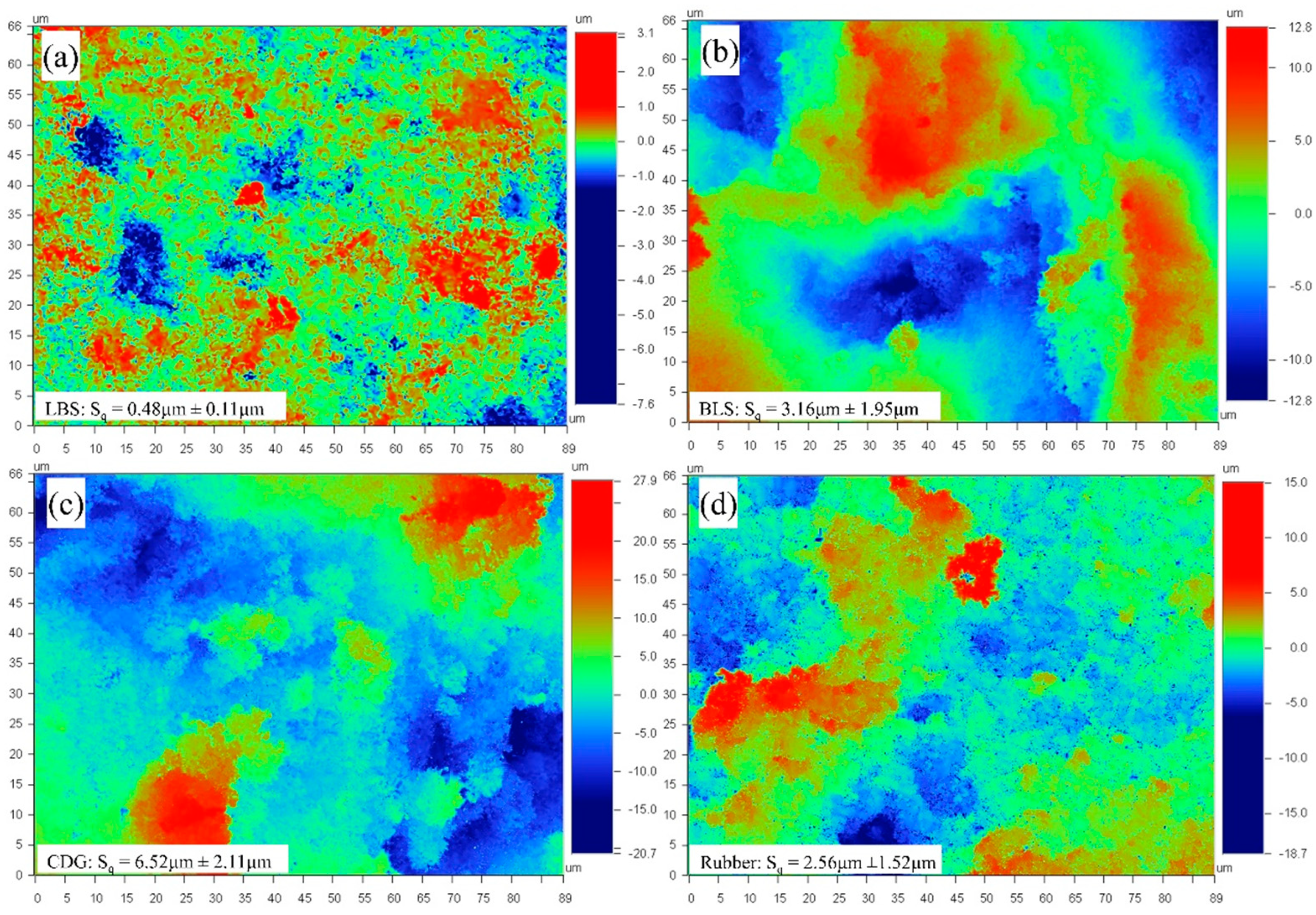


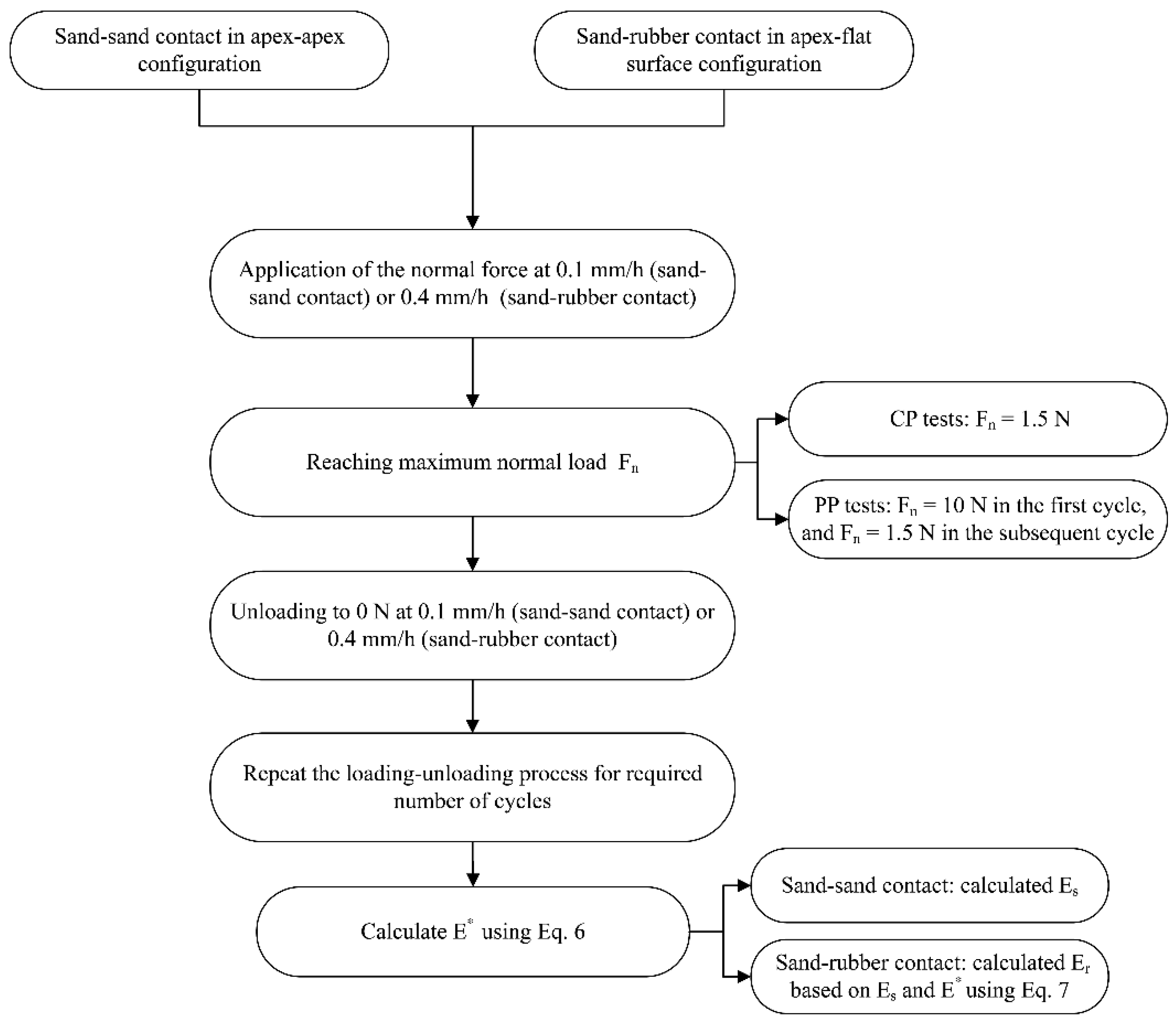
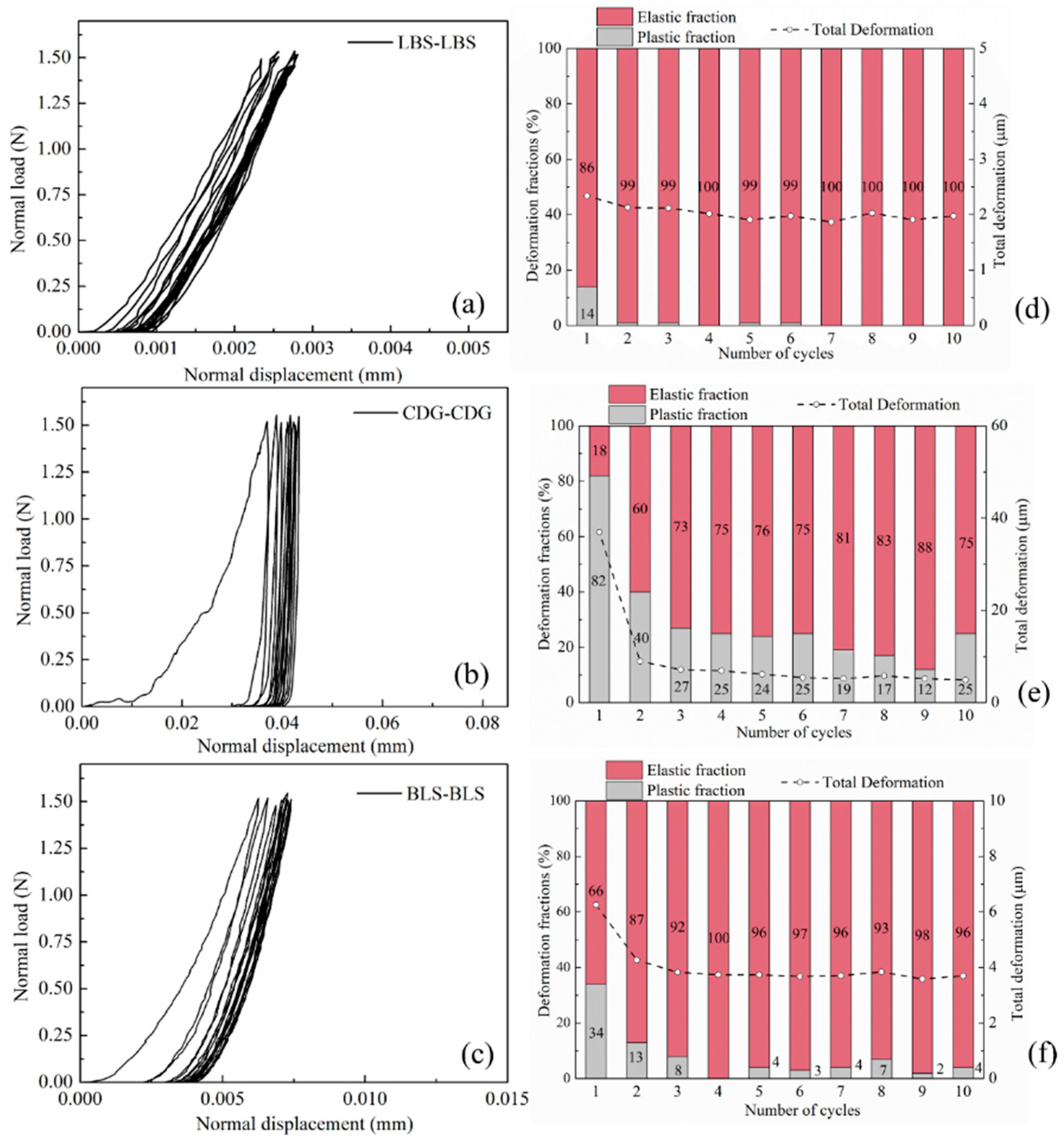

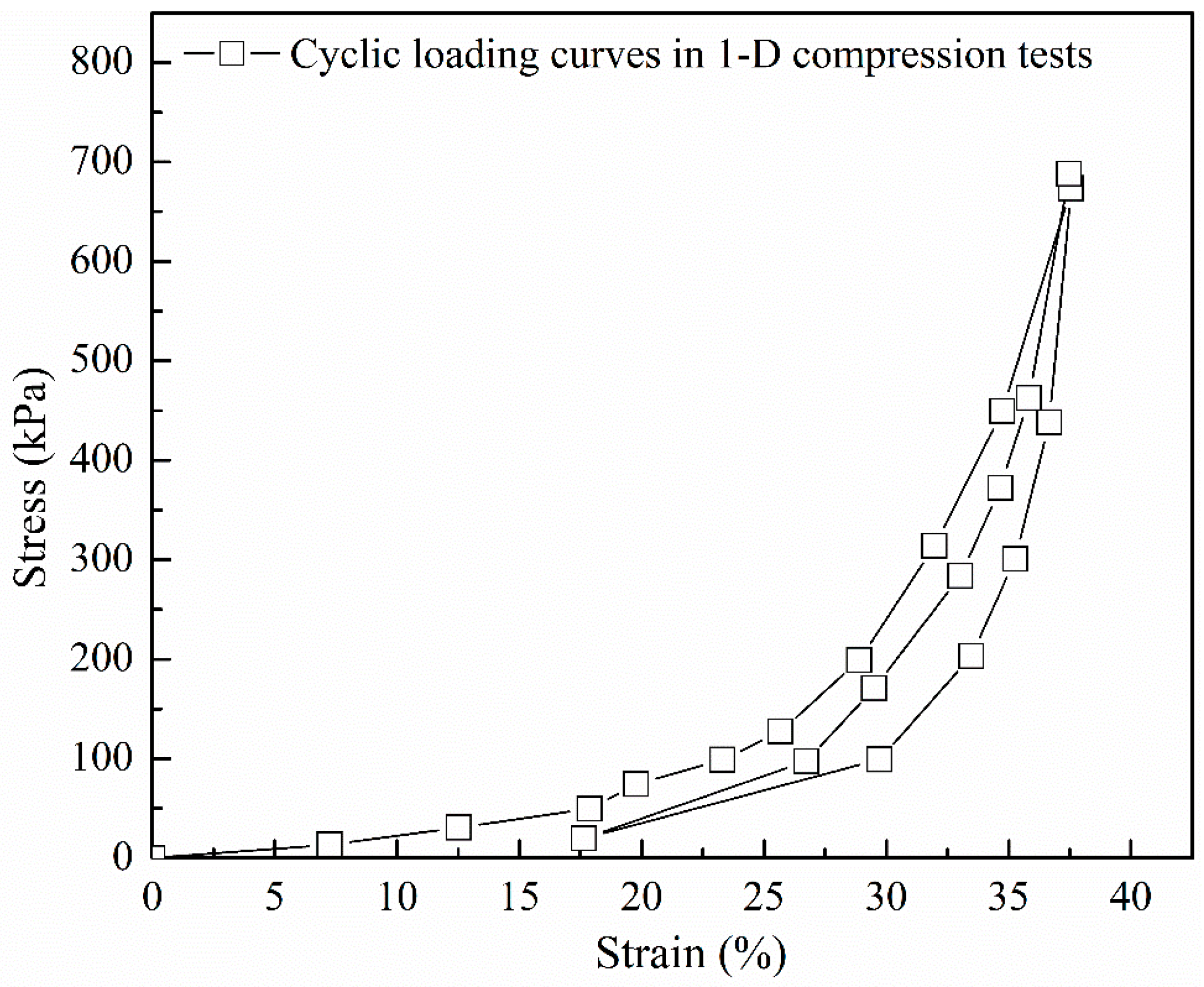



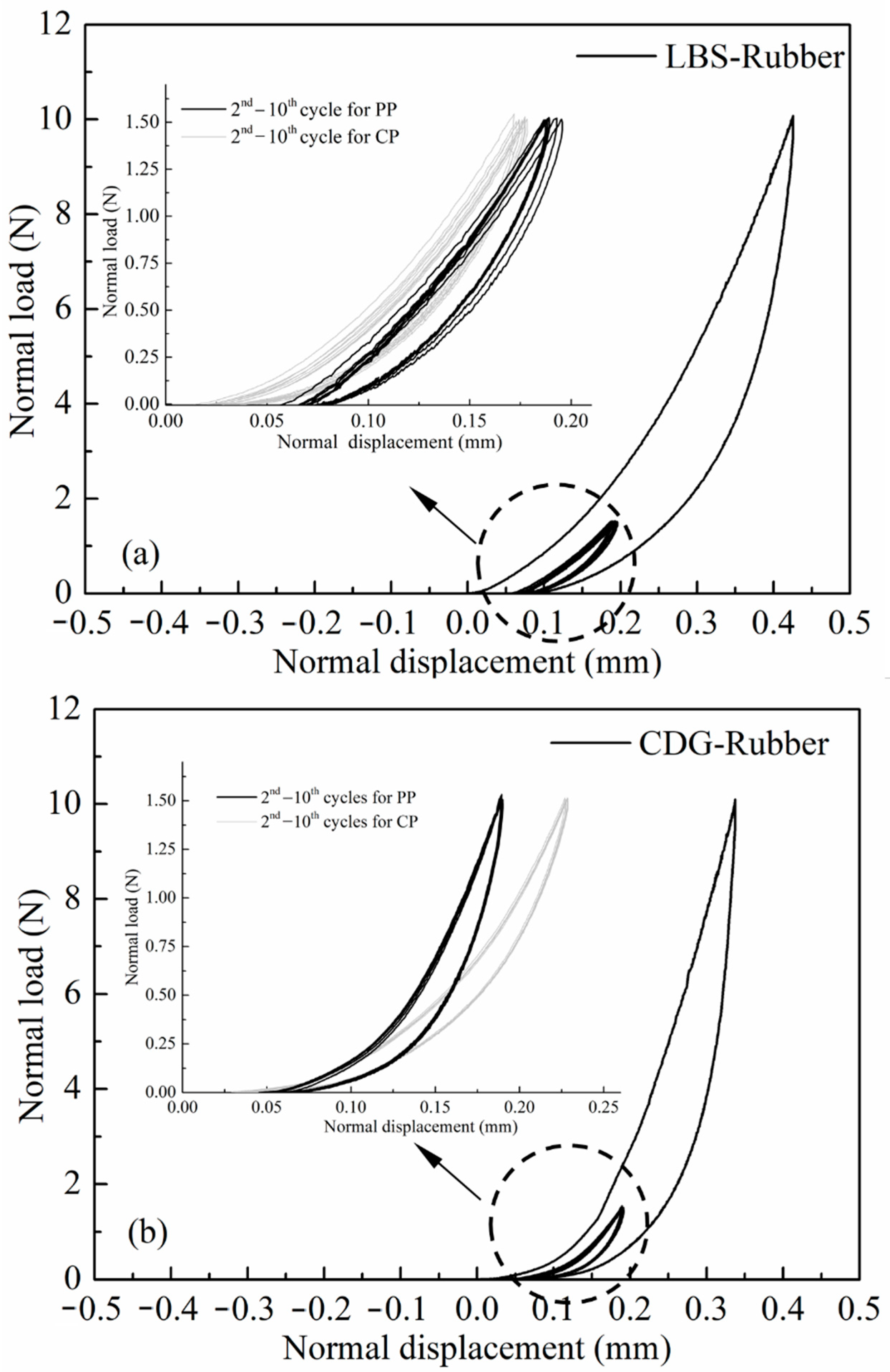


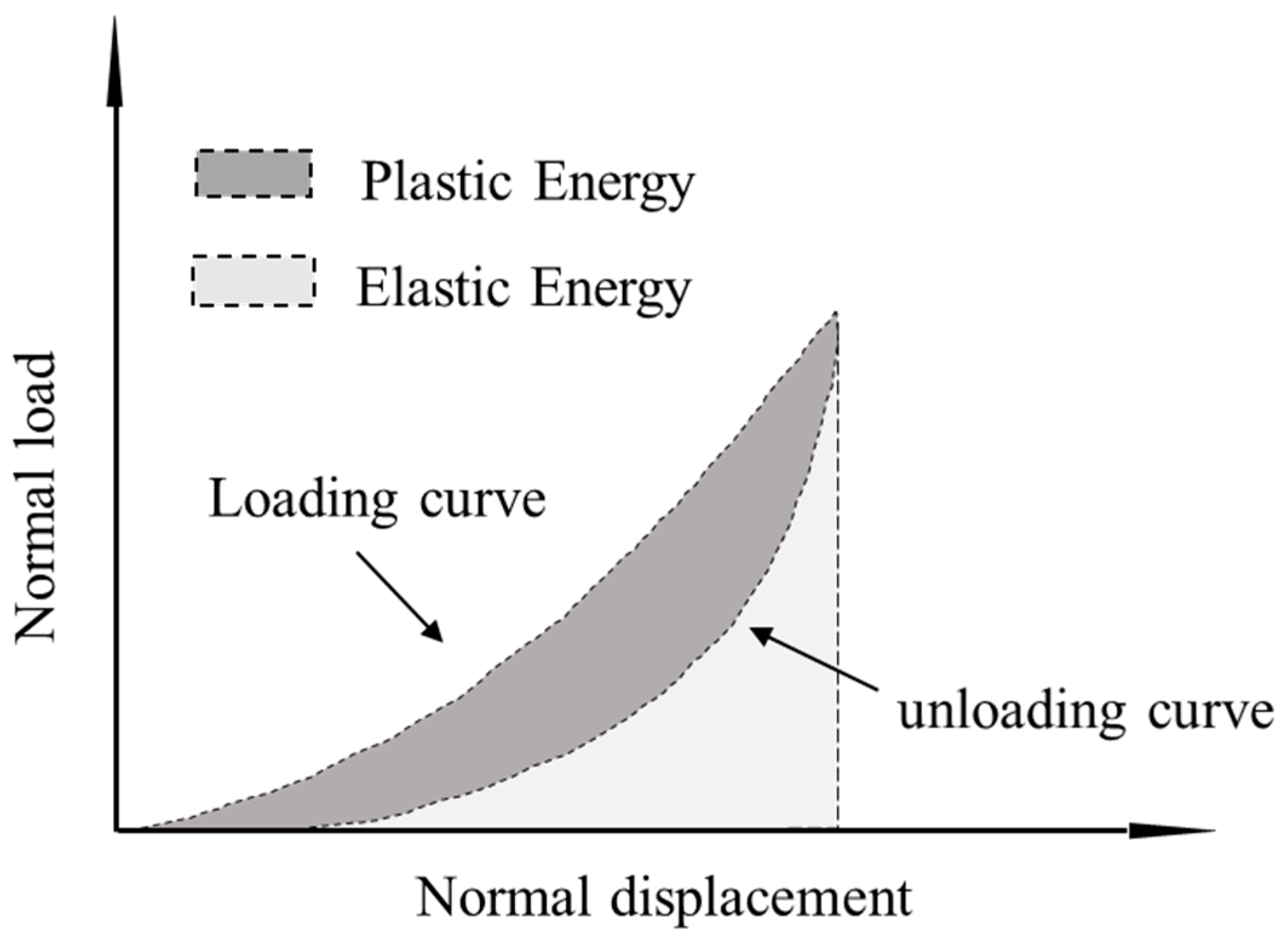

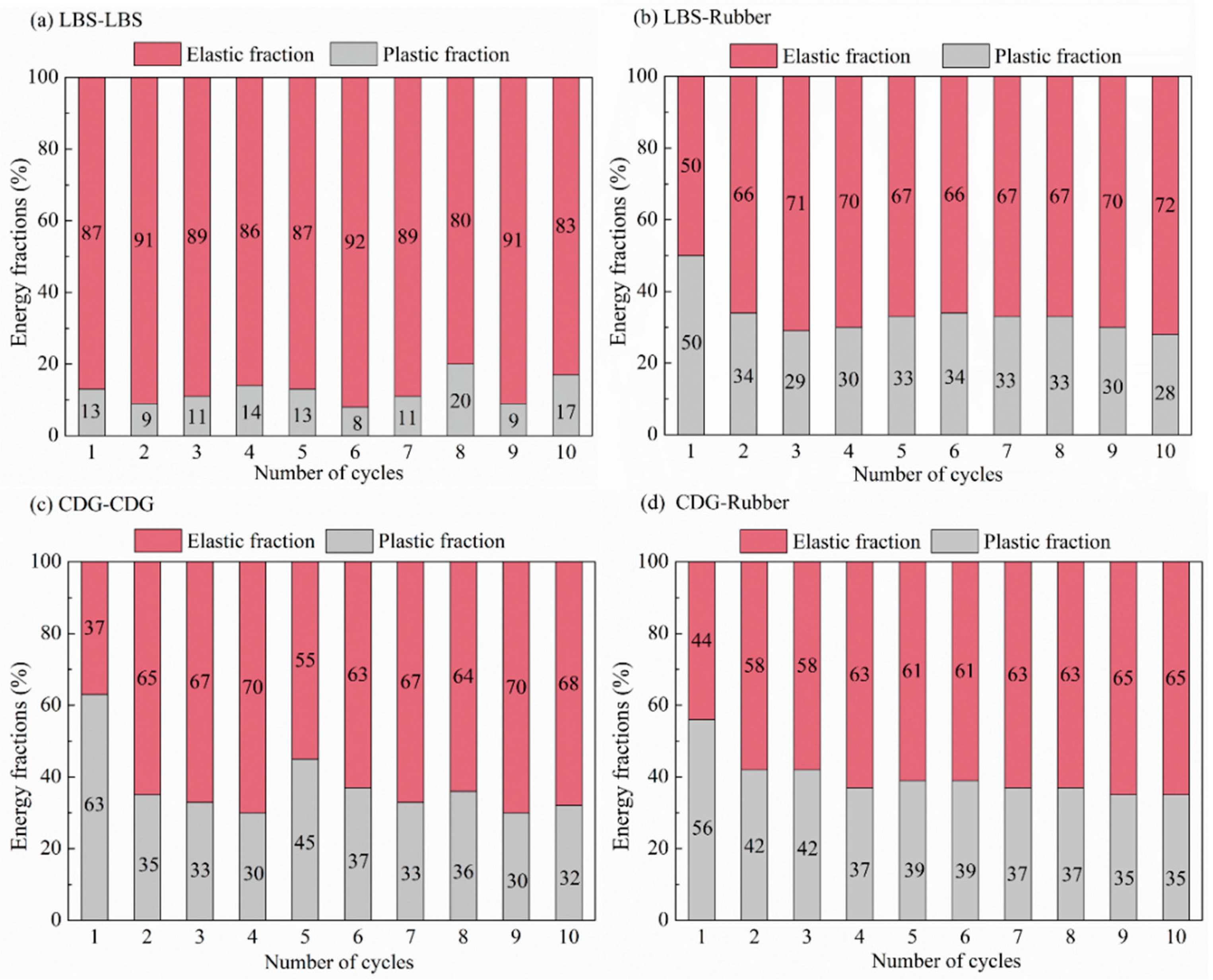
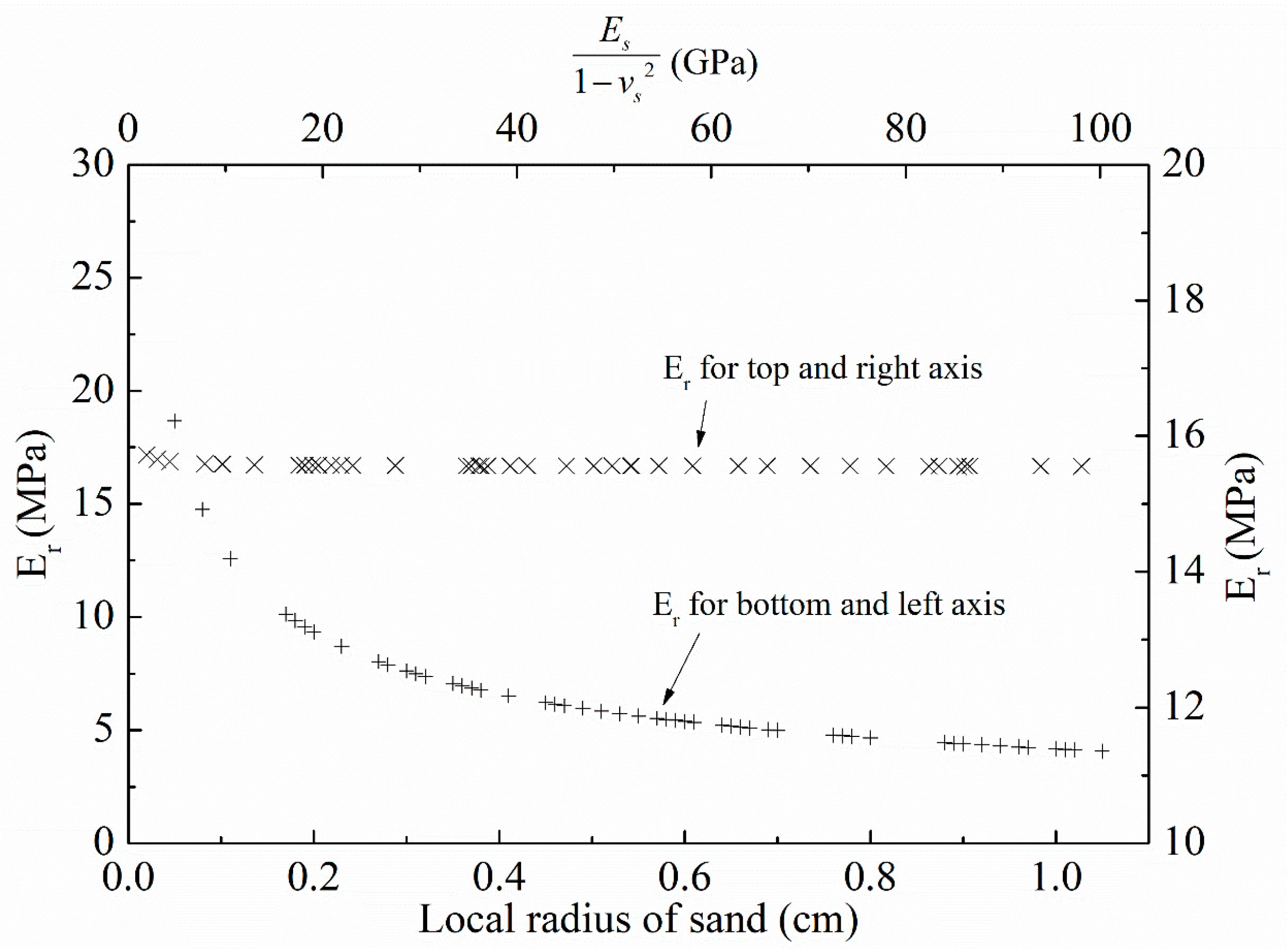

| Type | Loading Path | Local Radius (mm) | No. of Cycles | Maxium Load | |
|---|---|---|---|---|---|
| R1 | R2 | ||||
| LBS–LBS | Cyclic Loading | 0.24 | 0.32 | 10 | 1.5 N |
| LBS–rubber | 0.72 | ∞ | |||
| CDG–CDG | 1.00 | 0.51 | |||
| CDG–rubber | 0.99 | ||||
| BLS–BLS | 0.56 | 0.28 | |||
| BLU–rubber | - | ∞ | |||
| LBS–LBS | Preloading | 0.36 | 0.32 | 10 | 10 N(1st cycle) |
| LBS–rubber | 0.81 | ||||
| CDG–CDG | 0.31 | 0.62 | |||
| CDG–rubber | 0.47 | ∞ | |||
| Specimen Type | Es (GPa) | νs | Er (MPa) | νr | E * | R2 |
|---|---|---|---|---|---|---|
| LBS–LBS-1 | 53 | 0.1 * | - | - | 27 GPa | 0.99 |
| LBS–LBS-2 | 59 | - | - | 30 GPa | 0.99 | |
| LBS–LBS-3 | 61 | - | - | 31 GPa | 0.99 | |
| LBS–rubber-1 | 58 | 16 | 0.5 | 21 MPa | 0.99 | |
| LBS–rubber-2 | 58 | 18 | 24 MPa | 0.99 | ||
| LBS–rubber-3 | 58 | 18 | 25 MPa | 0.99 | ||
| CDG–CDG-1 | 0.7 | 0.25 ** | - | - | 0.4 GPa | 0.97 |
| CDG–CDG-2 | 9 | - | - | 5 GPa | 0.98 | |
| CDG–CDG-3 | 18 | - | - | 10 GPa | 0.99 | |
| CDG–rubber-1 | 9.2 | 10 | 0.5 | 13 MPa | 0.98 | |
| CDG–rubber-2 | 9.2 | 12 | 16 MPa | 0.99 | ||
| CDG–rubber-3 | 9.2 | 12 | 16 MPa | 0.99 |
Publisher’s Note: MDPI stays neutral with regard to jurisdictional claims in published maps and institutional affiliations. |
© 2021 by the authors. Licensee MDPI, Basel, Switzerland. This article is an open access article distributed under the terms and conditions of the Creative Commons Attribution (CC BY) license (https://creativecommons.org/licenses/by/4.0/).
Share and Cite
Tian, Y.; Kasyap, S.S.; Senetakis, K. Influence of Loading History and Soil Type on the Normal Contact Behavior of Natural Sand Grain-Elastomer Composite Interfaces. Polymers 2021, 13, 1830. https://doi.org/10.3390/polym13111830
Tian Y, Kasyap SS, Senetakis K. Influence of Loading History and Soil Type on the Normal Contact Behavior of Natural Sand Grain-Elastomer Composite Interfaces. Polymers. 2021; 13(11):1830. https://doi.org/10.3390/polym13111830
Chicago/Turabian StyleTian, Yu, Sathwik S. Kasyap, and Kostas Senetakis. 2021. "Influence of Loading History and Soil Type on the Normal Contact Behavior of Natural Sand Grain-Elastomer Composite Interfaces" Polymers 13, no. 11: 1830. https://doi.org/10.3390/polym13111830







